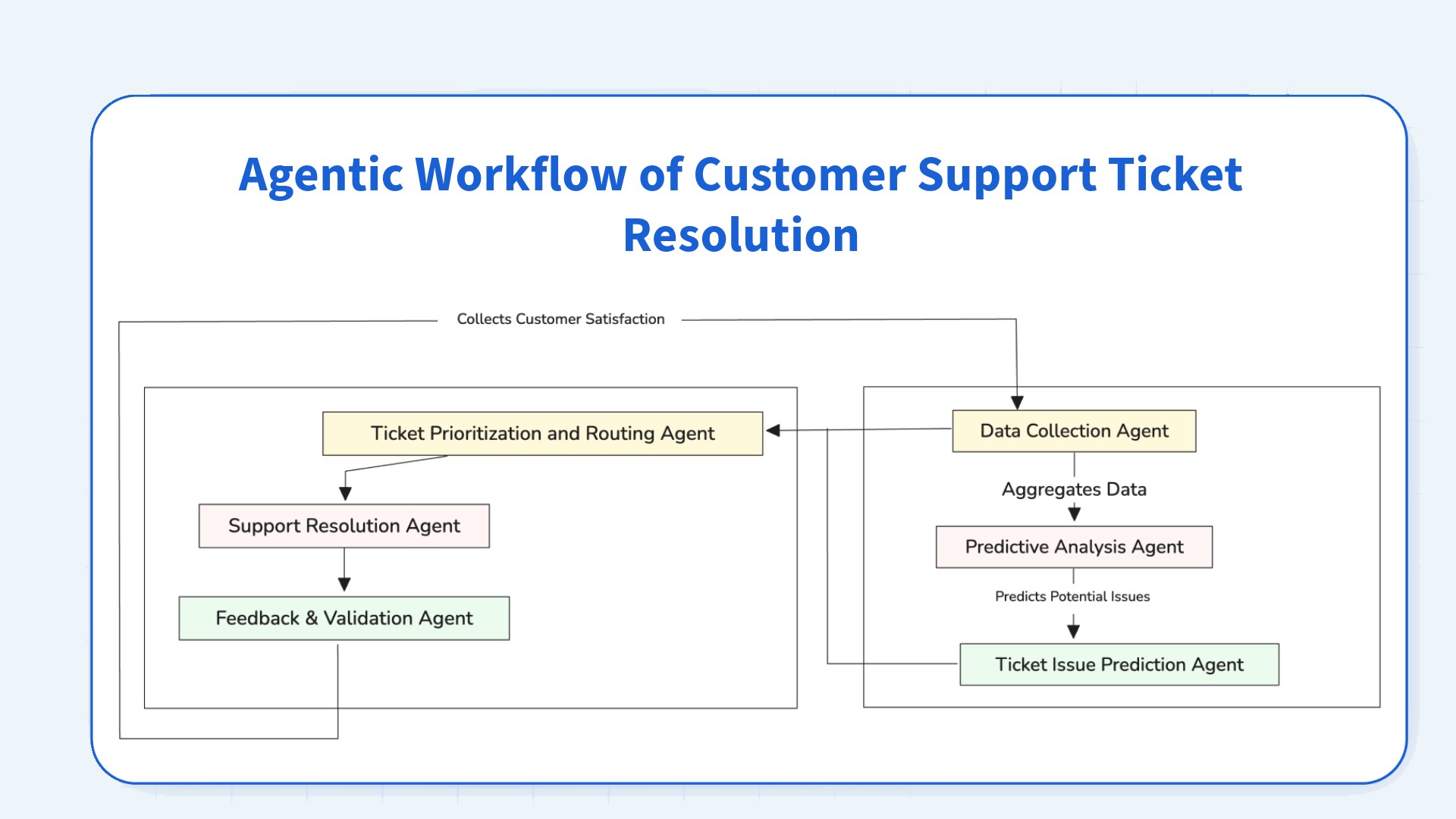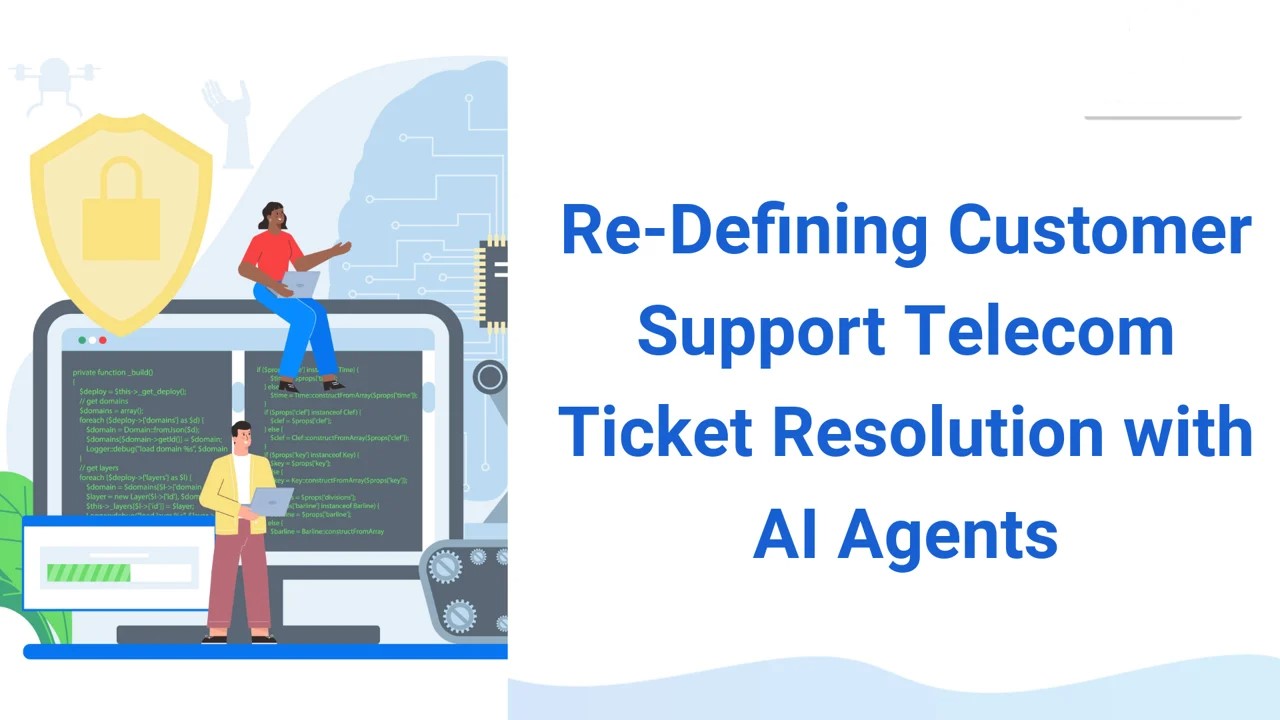Predictive customer support ticket resolution in telecommunications uses historical data to forecast issue resolution times, improving efficiency. AI agents automate ticket categorization, prioritize urgent issues, and allocate resources optimally, enhancing response speed. This proactive approach boosts customer satisfaction, reduces operational costs, and supports seamless telecom service delivery.
Efficient and timely customer support is a cornerstone of success in the telecommunications industry. However, managing and resolving support tickets swiftly, especially in the face of increasing customer demands, remains a persistent challenge. Predictive analytics, empowered by AI Agents, offers a groundbreaking solution by enabling telecom providers to estimate ticket resolution times with precision, leveraging historical and real-time data.
This transformative approach utilizes AI-driven pattern discovery, trend analysis, and predictive modeling to forecast resolution durations, empowering customers with clear expectations and enabling providers to allocate resources effectively. By harnessing the capabilities of Agentic AI, telecommunications companies can enhance operational efficiency, reduce churn, and deliver superior customer experiences. This blog delves into the role of predictive analytics in revolutionizing customer support in the telecom sector and how AI Teammates make it possible.
What is Predictive Customer Support Ticket Resolution?
Predictive customer support ticket resolution in telecommunications refers to the practice of leveraging historical customer service data to predict the resolution time for incoming support tickets. By analyzing past ticket trends, telecom companies can forecast how long it will take to address a customer’s issue based on factors such as the type of problem, the complexity, and the customer’s previous interactions. This allows telecom providers to prioritize tickets that require more time or resources, enhancing operational efficiency. It also improves customer satisfaction by setting more accurate expectations about when their issue will be resolved. Additionally, it helps telecom companies optimize resource allocation, ensuring that support teams are equipped to handle high-priority tickets quickly while maintaining a smooth workflow.
A Brief Overview of Predictive Customer Support Ticket Resolution in Telecommunications
Predictive customer support ticket resolution in telecommunications uses advanced analytics to anticipate ticket resolution times, enhancing the speed and accuracy of customer service. By analyzing historical customer interaction data and identifying patterns in issues and their resolutions, telecom companies can forecast how long it will take to resolve incoming tickets. This proactive approach helps companies to prioritize tickets based on complexity and urgency, rather than addressing them on a first-come, first-served basis. AI agents, in particular, play a key role by automating the identification of high-priority tickets and offering data-driven insights into customer issues, which can improve response times.
AI agents further enhance this process by improving ticket categorization, automating responses to common issues, and ensuring resources are optimally allocated. They analyze data from various sources, such as previous service interactions, customer profiles, and even external factors like weather or network status, to predict which issues are likely to arise. This predictive capability enables telecom companies to allocate the right support agents to high-priority tickets and resolve issues before they escalate. By doing so, companies can improve customer satisfaction, lower operational costs, and create a more efficient customer support system that meets the growing demands of today’s telecom customers.
Traditional vs. Agentic AI Customer Support Ticket Resolution
| Aspect | Traditional Approaches | Agentic AI Workflows |
| Problem Detection | Reactive – Issues are identified only after customers report them. | Predictive – Issues are identified before customers report them using data patterns and AI analysis. |
| Response Time | Delayed – Longer wait times due to manual ticket handling. | Immediate – Proactive solutions and automated responses for quicker resolutions. |
| Customer Satisfaction | Often low – Long wait times and generic responses can frustrate customers. | High – Personalized, proactive solutions lead to better customer experiences. |
| Cost Efficiency | High – Requires a large team of agents to handle a high volume of tickets. | Low – AI handles multiple tickets simultaneously, reducing operational costs. |
| Ticket Resolution Accuracy | Moderate – Human error and limited data analysis can result in incorrect resolutions. | It analyzes large datasets to provide accurate, data-driven solutions. |
Agentic AI Multi-Agent in Action

Utilizing Agentic AI in resolving customer support tickets is a complex but organized task.
- Agent for collecting Agentic data: This agent collates data from diverse sources like customer support tickets, network surveillance systems, customer reviews, etc., in order to provide an all-rounded picture of a customer and most likely problems.
- Predictive analysis agent: After the data has been collected, this agent makes the review to address the possible problems an awaiting customer may have including but not limited to service outages, billing issues, and any other technical problems, therefore, preventing issues before they occur.
- Ticket Issue Prediction Agent: After an issue is predicted, this agent assigns the ticket to several dimensions including priority, difficulty, and even the potential risk of the issue ensuring that all the issues are properly flagged and placed in the right queue.
- Ticket prioritization and Routing Agent: This agent assigns the categorized requests for support to specified agents, based on the agents’ skill levels and the agents’ workload.
- Resolution and feedback agent: This agent offers remedies when issues vehicle purpose or offers ready solutions to issues in real-time. After the agents validate and close a resolution, the system requests customer satisfaction ratings, which are later employed in aiding future forecasts and enhancing the overall workings of the system.
Use Cases of Telecom Ticket Resolution
- Ticket Prioritization and Routing: Based on past data, predictive systems can determine which tickets are likely to be more complex or time-sensitive, allowing them to be routed to the most appropriate support agents quickly.
- Automated Responses for Common Issues: By analyzing recurring patterns in customer queries, systems can automatically generate responses for common issues, reducing the workload for support agents and accelerating ticket resolution.
- Resolution Time Prediction: By examining historical ticket resolution data, systems can predict the time required for ticket resolution. This helps manage customer expectations by providing more accurate timelines for when their issues will be resolved.
- Proactive Issue Identification: Predictive analytics can highlight emerging issues based on trends in support tickets, allowing telecom companies to address these issues before they escalate, potentially preventing future tickets and improving overall service quality.
- Optimizing Resource Allocation: With insights into ticket volume, complexity, and required resolution times, telecom companies can allocate the right support staff at the right time, ensuring that high-priority issues are resolved promptly.
- Customer Sentiment Analysis: Analyzing customer feedback and sentiment can help predict the likelihood of customer dissatisfaction, enabling agents to resolve issues more effectively and reduce the chances of escalation.
Operational Benefits of Predictive Customer Support Ticket Resolution
- Faster Response and Resolution Times: By predicting the volume and severity of incoming tickets, telecom companies can allocate resources more effectively. This ensures faster response times and a more efficient handling process, reducing customer wait times and improving overall resolution speed.
- Cost Reduction: Predictive models streamline operations by automating routine tasks, such as ticket categorization and prioritization. This reduces manual intervention, leading to cost savings and allowing support teams to focus on more complex issues, enhancing both operational efficiency and bottom-line performance.
- Optimized Resource Allocation: With accurate predictions of peak ticket volumes, telecom companies can adjust staffing levels dynamically. This proactive approach ensures the right number of agents are available at the right times, maximizing resource utilization while avoiding overstaffing or understaffing during peak periods.
- Improved Customer Satisfaction: Predictive analytics allows telecom providers to set realistic expectations for customers regarding ticket resolution times. By forecasting potential delays and proactively addressing common issues, businesses can prevent frustration, leading to higher customer satisfaction and loyalty.
- Scalability: Telecom companies can scale their customer support operations more easily by integrating predictive analytics. As customer demand fluctuates, predictive models help adjust workflows to maintain high service levels, ensuring consistent quality even during periods of high demand.
Technology Transforming Ticket Resolution
Numerous factors are causing a paradigm shift in predictive customer support ticket resolution based on telecommunications:
- Machine Learning: It is the self-improvement of AI models by techniques involving the incorporation of fresh information. Thus, this system enhances over time the accuracy of its predictions.
- Natural Language Processing (NLP): Technical effiency that makes it possible for Agents to output relevant responses to customer questions, as clearly as a human would do. This enriches the self-service capabilities of the users.
- Data Analytics: Evaluation of past and current status data with a view of identifying patterns and forecasting likely challenges.
- Intelligent chatbots and virtual agents: Extend customers’ capability through self-service by resolving easy and repetitive tickets without involving a human.
- Cloud Technology: Provides an opportunity for telcos to deploy AI within their operations on a global footprint without time constraints and in a cost-effective way.
The Future Trends of AI Agents for Customer Support Ticket Resolution
- Enhanced Predictive Capabilities: Predictive models will become more advanced, allowing telecom companies to forecast potential issues before they arise. This approach will enable proactive support, reducing the time spent on troubleshooting and improving the speed of issue resolution.
- Omnichannel Integration: Customer support will increasingly be available across multiple platforms, such as chat, phone, social media, and email. The integration of these channels will create a unified experience where customers can seamlessly transition between them while maintaining the context of their support issues.
- Self-Service and Automation: The rise of automated solutions will enable customers to resolve basic issues independently, reducing the need for human intervention in simple queries. These systems will continuously improve, providing faster resolutions and improving overall operational efficiency.
- Root Cause Analysis: Predictive systems will not only solve individual customer problems but also identify recurring issues across tickets. This will help companies address systemic problems and improve their products and services, reducing the frequency of similar issues.
- IoT and 5G Integration: With the expansion of 5G networks and the Internet of Things (IoT), predictive systems will be able to handle complex issues arising from connected devices. These technologies will allow for real-time issue detection and resolution, enhancing the customer experience in an increasingly connected world.
Conclusion: Predictive Customer Support Ticket Resolution with Agentic AI
As an innovation, the application of Agentic AI in the customer support system of the telecommunications industry presents a paradigm shift in how the sector undertakes service requests. Moving from a reactive approach and adopting the active support model, telecom operators can now provide faster, more precise, and tailored solutions to customers.
With AI technologies constantly improving, the future of customer care in the telecom sector will no doubt have much more advanced predictive elements to keep businesses at par in a fast-evolving environment. In the same vein as AI development goes, anticipating, avoiding, and most importantly solving customer challenges will be aimed for with such precision that the above is going to be scored as the new gold standard for customer service.



